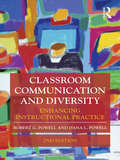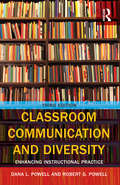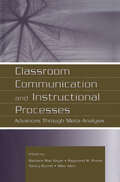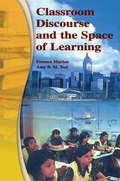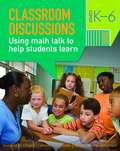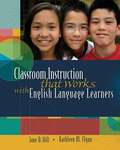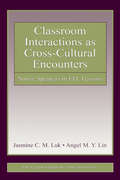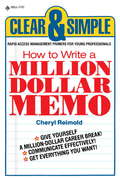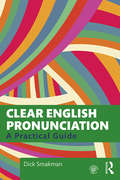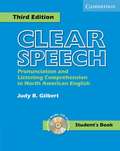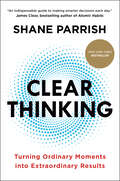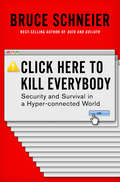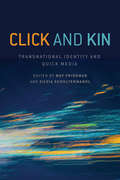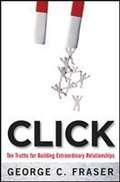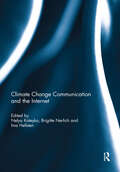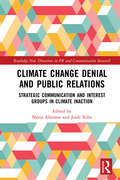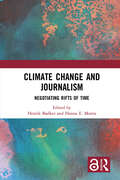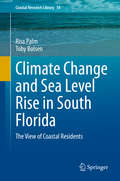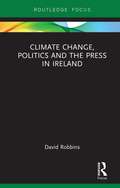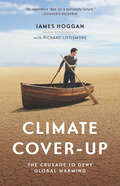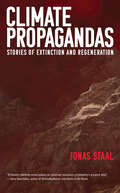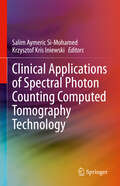- Table View
- List View
Classroom Communication and Diversity: Enhancing Instructional Practice
by Robert G. Powell Dana L. PowellClassroom Communication and Diversity is an integral resource for teaching awareness of diversity issues and communication in the classroom. Drawing on the research in the communication and education disciplines, authors Robert G. Powell and Dana Caseau provide theoretical models and useful strategies for improving instructional practices. They address the ways in which culture influences communication in the classroom, and assist teachers in developing the skills necessary to meet the needs of the students in their classrooms. New to the second edition is an expanded skills component, additional teaching resources, and an increased focus on the role of diversity in the classroom. Much of the information shared in this text derives from the authors' research and experience in schools and from the experiences of others, including teachers, parents, and children. Their experiences, combined with the cross-disciplinary approach, produce a volume of unique perspectives and considerable insight.
Classroom Communication and Diversity: Enhancing Instructional Practice (Routledge Communication Series)
by Robert G. Powell Dana L. PowellClassroom Communication and Diversity provides a useful framework for helping both new and experienced teachers and instructors navigate the communication challenges in today’s diverse classroom. It encourages teachers to reflect on how their personal cultures influence their expectations regarding classroom communication. This textbook is distinctive in its distillation of research from numerous sources to provide the best viewpoint and systems for focusing on the needs of the individual learner. Dana L. Powell and Robert G. Powell draw on research in both the communication and education disciplines, and provide useful strategies for improving teaching practices alongside theoretical models regarding diversity in the classroom. Much of the information found in this text is also inspired by the authors’ direct experience in schools and from the experience they have gleaned from other first-line instructors as well as from parents and children. Among the many updates to this Third Edition are: Expanded coverage of students with diverse needs Discussion on working effectively with parents Coverage of cultural influences and the impact of race and ethnicity on disciplinary actions Examination of the role of social media and its impact on instructional communication The increase of educational technology use. Teachers and scholars in the communication and education fields will find this text practical and valuable for their teaching efforts, and it is appropriate for instructional communication courses in both disciplines.
Classroom Communication and Instructional Processes: Advances Through Meta-Analysis (Routledge Communication Series)
by Mike Allen Barbara Mae Gayle Raymond W. Preiss Nancy BurrellThis volume offers a systematic review of the literature on communication education and instruction. Making meta-analysis findings accessible and relevant, the editors of this volume approach the topic from the perspective that meta-analysis serves as a useful tool for summarizing experiments and for determining how and why specific teaching and learning experiences have positive student outcomes. The topics covered here are meaningful and relevant to classroom practice, and each chapter offers a summary of existing quantitative social science research using meta-analysis. With contributions from experienced researchers throughout the communication discipline, this work provides a unique analysis of research in instructional communication.Taken together, the chapters in this volume enhance understanding of behaviors, practices, and processes that promote positive student outcomes. This book is a must-read for scholars, graduate students, and researchers in communication education, and will also be of interest to scholars and researchers in education.
Classroom Discourse and the Space of Learning
by Ference Marton Amy B.M. Tsui Pakey P.M. Chik Po Yuk Ko Mun Ling LoClassroom Discourse and the Space of Learning is about learning in schools and the central role of language in learning. The investigations of learning it reports are based on two premises: First, whatever you are trying to learn, there are certain necessary conditions for succeeding--although you cannot be sure that learning will take place when those conditions are met, you can be sure that no learning will occur if they are not. The limits of what is possible to learn is what the authors call "the space of learning." Second, language plays a central role in learning--it does not merely convey meaning, it also creates meaning. The book explicates the necessary conditions for successful learning and employs investigations of classroom discourse data to demonstrate how the space of learning is linguistically constituted in the classroom.Classroom Discourse and the Space of Learning:*makes the case that an understanding of how the space of learning is linguistically constituted in the classroom is best achieved through investigating "classroom discourse" and that finding out what the conditions are for successful learning and bringing them about should be the teacher's primary professional task. Thus, it is fundamentally important for teachers and student teachers to be given opportunities to observe different teachers teaching the same thing, and to analyze and reflect on whether the classroom discourse in which they are engaged maximizes or minimizes the conditions for learning;*is both more culturally situated and more generalizable than many other studies of learning in schools. Each case of classroom teaching clearly demonstrates how the specific language, culture, and pedagogy molds what is happening in the classroom, yet at the same time it is possible to generalize from these culturally specific examples the necessary conditions that must be met for the development of any specific capability regardless of where the learning is taking place and what other conditions might be present; and *encompasses both theory and practice--providing a detailed explication of the theory of learning underlying the analyses of classroom teaching reported, along with close analyses of a number of authentic cases of classroom teaching driven by classroom discourse data which have practical relevance for teachers.Intended for researchers and graduate students in education, teacher educators, and student teachers, Classroom Discourse and the Space of Learning is practice- and content-oriented, theoretical, qualitative, empirical, and focused on language, and links teaching and learning in significant new ways.
Classroom Discussions: Using Math Talk to Help Students Learn, Grades K-6 (2nd edition)
by Catherine O'Connor Suzanne H. Chapin Nancy Canavan AndersonThis best-selling resource offers an unparalleled look at the significant role that classroom discussions can play in teaching mathematics. New to this edition are more research-based examples of classroom talk at early grade levels, an expanded range of vignettes, discussion questions at the end of each chapter, and connections to NCTM standards.
Classroom Instruction That Works With English Language Learners
by Jane Hill Kathleen FlynnAs more and more English language learners (ELLs) are included in mainstream classrooms, what can we do to ensure that they understand academic content and develop their English language skills? To answer this question, authors Jane Hill and Kathleen Flynn have examined decades of research, interviewed mainstream teachers with ELLs in their classrooms, and reviewed the classroom recommendations from Marzano, Pickering, and Pollock's seminal Classroom Instruction That Works (2001) through an ELL lens. The result is Classroom Instruction That Works with English Language Learners—-a comprehensive guide to helping elementary school students at all levels of English language acquisition succeed. <p><p> The strategies discussed in the book include homework and practice, summarization and note taking, and use of nonlinguistic representations, among many others. For each strategy, the authors provide a summary of the research, detailed examples of how to modify the strategy for use with ELLs in mainstream classrooms, and teacher accounts of implementation. Because ELLs face cultural hurdles as well as linguistic ones, this book also shows teachers how to glean insight into students' backgrounds and address the cultural biases inherent in many classroom practices. <p> Accommodating English language learners is one of the greatest challenges educators face today. Just as different levels of fluency require different approaches, so too do different backgrounds and languages. This practical, research-based book gives elementary school teachers the guidance they need to help ELLs of all nationalities thrive alongside their English-dominant peers.
Classroom Interactions as Cross-Cultural Encounters: Native Speakers in EFL Lessons (ESL & Applied Linguistics Professional Series)
by Angel M. Lin Jasmine C. LukClassroom Interactions as Cross-Cultural Encounters is about native English speakers teaching English as a global language in non-English speaking countries. Through analysis of naturally occurring dialogic encounters, the authors examine the multifaceted ways in which teachers and students utilize diverse communicative resources to construct, display, and negotiate their identities as teachers, learners, and language users, with different pedagogic, institutional, social, and political implications. A range of issues in applied linguistics is addressed, including linguistic imperialism, post-colonial theories, micropolitics of classroom interaction, language and identity, and bilingual classroom practices. Intended to help TESOL professionals of different cultural backgrounds, working in different sociocultural contexts, to critically understand how non-assimilationist, dialogic intercultultural communication with students can be achieved and built on for mutual cultural and linguistic enrichment and empowerment, this book:*emphasizes the sociocultural meanings and micropolitics of classroom interactions that reveal the complex realities of power and identity negotiations in cross-cultural interactions in ELT (English Language Teaching) classroom contexts;*revisits and reconstitutes the notion of native-speakerness and repositions the roles of native and non-native English teachers in the TESOL profession in the contexts of decolonization and globalization; *highlights the need to mobilize intercultural communicative resources for global communication;*addresses two major concerns of EFL (English as a Foreign Language) classroom researchers and teachers: student resistance and learning motivation; and*examines and analyzes the changing ideologies (both explicit and implicit) of teachers and students about English learning in the context of a post-colonial society, and how these ideologies are being enacted, reproduced, but also sometimes contested in EFL classroom interactions. Each chapter includes Questions for Reflection and Discussion to promote critical thinking and understanding of the issues discussed. Tuning-In discussion questions are provided in the three chapters on classroom data analysis to activate readers interpretive schemas before they examine the actual classroom episodes. The data are from an ethnographic study in post-colonial Hong Kong secondary schools involving four native English-speaker teachers and two bilingual Cantonese-English speaking teachers engaged in intercultural classroom dialogues with their Cantonese Hong Kong students. The rich, naturally occurring classroom data and in-depth analyses provide useful pedagogical materials for courses in EFL teacher education programs on classroom discourse analysis from sociocultural perspectives.
Claudio Paolillo. Periodista: Columnas, clases y discursos
by Claudio PaolilloEste libro es el legado profesional de uno de los periodistas más importantes del último medio siglo en Uruguay. Los textos escogidos, varios de ellos inéditos, son el resultado de una selección de más de cuarenta años de periodismo donde todos los jueves Paolillo se convirtió en un analista de la actualidad referente en el país. Claudio Paolillo ha sido uno de los periodistas más influyentes en Uruguay desde el retorno de la democracia. Sus columnas en Búsqueda atraparon lectores, inquietaron gobernantes y marcaron agenda. Sus discursos en defensa de la libertad en los foros más encumbrados del continente demostraron su valentía y liderazgo. Sus clases de periodismo, en la redacción y en las aulas, siempre apasionadas y profundas, calaron hondo en generaciones de periodistas. Este libro, que incluye material inédito, reúne muchos de sus trabajos más emblemáticos para lograr ilustrar el pensamiento de un profesional admirado en toda América. Claudio Paolillo. Periodista es un libro de una vigencia impactante, que explica el rol del periodismo contemporáneo y resulta una lectura esencial para entender la sociedad, la política y la cultura del Uruguay. Es también un homenaje a su trayectoria, una invitación a pensar con libertad y una fuente de inspiración para el futuro.
Clear & Simple: How to Write a Million Dollar Memo
by Cheryl ReimoldHow to Write a Million Dollar Memo is a guide to writing clear and simple business communications.
Clear English Pronunciation: A Practical Guide
by Dick SmakmanClear English Pronunciation provides students with the tools to effectively communicate in English without centring solely on native-speaker pronunciation models. The focus of the book is on individual pronunciation targets rather than a one-size-fits-all approach. Divided into four sections, each featuring detailed articulatory explanations, sample sentences, and recordings to help learners improve their pronunciation, this book: introduces the phenomenon of pronunciation as part of a broader communicative realm; explains and demonstrates the melody and rhythm of understandable and natural English pronunciation; supports students in identifying and practicing their own pronunciation issues. Supported by an interactive companion website which features recordings and expanded explanations of key topics, Clear English Pronunciation is an essential textbook for international learners of English who want to improve their pronunciation skills in diverse social settings. https://www.universiteitleiden.nl/clearenglishpronunciation
Clear Speech: Pronunciation and Listening Comprehension in North American English (3rd Edition)
by Judy B. GilbertThis book is designed to help students make the most efficient use of their time as they learn to pronounce English better.
Clear Thinking: Turning Ordinary Moments into Extraordinary Results
by Shane ParrishINSTANT NEW YORK TIMES BESTSELLER * GLOBE AND MAIL BESTSELLER * TORONTO STAR BESTSELLERFew things will change your trajectory in life or business as much as learning to think clearly. Yet few of us recognize opportunities to think in the first place.You might believe you&’re thinking clearly in the moments that matter most. But in all likelihood, when the pressure is on, you won&’t be thinking at all. And your subsequent actions will inevitably move you further from the results you ultimately seek—love, belonging, success, wealth, victory. According to Farnam Street founder Shane Parrish, we must get better at recognizing these opportunities for what they are, and deploying our cognitive ability in order to achieve the life we want.Clear Thinking gives you the tools to recognize the moments that have the potential to transform your trajectory, and reshape how you navigate the critical space between stimulus and response. As Parrish shows, we may imagine we are the protagonists in the story of our lives. But the sad truth is, most of us run on autopilot. Our behavioral defaults, groomed by biology, evolution, and culture, are primed to run the show for us if we don&’t intervene. At our worst, we react to events without reasoning, not even realizing that we&’ve missed an opportunity to think at all. At our best, we recognize these moments for what they are, and apply the full capacity of our reasoning and rationality to them.Through stories, mental models, and more, Parrish offers the missing link between behavioral science and real-life outcomes. The result is a must-have manual for optimizing decision-making, gaining competitive advantage, and living a more intentional life.
Clearing Emotional Clutter: Mindfulness Practices for Letting Go of What's Blocking Your Fulfillment and Transformation
by Donald AltmanA Fresh Start to a Healthy Emotional LifeIs emotional clutter blocking success in your personal and professional life? You’ve likely heard about the psychological benefits of clearing out the clutter in your surroundings, but how do you handle your emotional clutter - the psychological version of the jam-packed closet or impenetrable garage? Shutting away and trying to hide old pains and traumas creates toxic patterns that can keep you from having the life of your dreams. Integrating mindfulness and cutting-edge neuroscience, international mindfulness expert Donald Altman teaches how to modify entrenched habits and patterns with only a few minutes of attention daily.Altman first helps you realize what your baggage consists of and how to transform or jettison it. He then shows how to avoid the daily danger of accumulating new emotional clutter. No matter how fraught your life or relationships may be, you can cleanse, heal, or accept the old wounds, mistakes, and disappointments. With Altman’s lifestyle tools, you’ll discover how to address your past, better deal with the present, and cultivate the best possible future. Start fresh with Clearing Emotional Clutter.
Clearing the Air
by Daniel SchorrIn 1977 veteran TV newsman Daniel Schorr was forced to "resign" from CBS News and threatened with imprisonment by the U.S. government. His "crime"--releasing a damaging report on CIA corruption to the American people. Schorr refused to back down from his heroic decision and now he tells the full, dramatic story behind his two decades on the most explosive assignments in Washington: Watergate, the CIA and FBI scandals, the Kennedy assassination, and his own head on confrontation with Congress and CBS.
Click Here to Kill Everybody: Security And Survival In A Hyper-connected World
by Bruce SchneierA world of "smart" devices means the Internet can kill people. We need to act. Now. Everything is a computer. Ovens are computers that make things hot; refrigerators are computers that keep things cold. These computers—from home thermostats to chemical plants—are all online. The Internet, once a virtual abstraction, can now sense and touch the physical world. As we open our lives to this future, often called the Internet of Things, we are beginning to see its enormous potential in ideas like driverless cars, smart cities, and personal agents equipped with their own behavioral algorithms. But every knife cuts two ways. All computers can be hacked. And Internet-connected computers are the most vulnerable. Forget data theft: cutting-edge digital attackers can now crash your car, your pacemaker, and the nation’s power grid. In Click Here to Kill Everybody, renowned expert and best-selling author Bruce Schneier examines the hidden risks of this new reality. After exploring the full implications of a world populated by hyperconnected devices, Schneier reveals the hidden web of technical, political, and market forces that underpin the pervasive insecurities of today. He then offers common-sense choices for companies, governments, and individuals that can allow us to enjoy the benefits of this omnipotent age without falling prey to its vulnerabilities. From principles for a more resilient Internet of Things, to a recipe for sane government regulation and oversight, to a better way to understand a truly new environment, Schneier’s vision is required reading for anyone invested in human flourishing.
Click and Kin: Transnational Identity and Quick Media
by May Friedman Silvia SchultermandlClick and Kin is an interdisciplinary examination of how our increasingly mobile and networked age is changing the experience of kinship and connection. Focusing on how identity formation is affected by quick media such as instant messaging, video chat, and social networks, the contributors to this collection use ethnographic and textual analyses, as well as autobiographical approaches, to demonstrate the ways in which the ability to communicate across national boundaries is transforming how we grow together and apart as families, communities, and nations. The essays in Click and Kin span the globe, examining transnational connections that touch in the United States, Canada, Mexico, India, Pakistan, and elsewhere. Together, they offer a unique reflection on the intersection of new media, identity politics, and kinship in the twenty-first century.
Click: Ten Truths For Building Extraordinary Relationships
by George FraserIn this book you will find ten simple principles that will dispel your dread of networking forever and reveal a proven path to success and happiness. Imagine mastering the skills to create an extraordinary marriage, lifelong friendships, or powerful and enriching business relationships. That is what awaits you in Click: the tools to tap into the richest resource on the planet--other people--no matter how hard it's been for you to do so in the past.
Climate Change Communication and the Internet
by Nelya Koteyko, Brigitte Nerlich and Iina HellstenThe volume provides a timely, state of the art collection of studies examining climate change communication in the era of digital media. The chapters focus on a broad range of topics covering various aspects of both practice and research in climate change communication, ranging from the use of online platforms, to blogs, and social networking sites. Climate change communication has increasingly moved into Internet-based forums, and this volume provides a comprehensive overview of research into Internet and climate change communication. The studies share valuable methodological insights in this relatively new field of research and shed light on the opportunities and challenges underlying the collection and analysis of online climate change-related data. This book was previously published as a special issue of Environmental Communication.
Climate Change Denial and Public Relations: Strategic communication and interest groups in climate inaction (Routledge New Directions in PR & Communication Research)
by Núria Almiron Jordi XifraThis is the first book on climate change denial and lobbying that combines the ideology of denial and the role of anthropocentrism in the study of interest groups and communication strategy. Climate Change Denial and Public Relations: Strategic Communication and Interest Groups in Climate Inaction is a critical approach to climate change denial from a strategic communication perspective. The book aims to provide an in-depth analysis of how strategic communication by interest groups is contributing to climate change inaction. It does this from a multidisciplinary perspective that expands the usual approach of climate change denialism and introduces a critical reflection on the roots of the problem, including the ethics of the denialist ideology and the rhetoric and role of climate change advocacy. Topics addressed include the power of persuasive narratives and discourses constructed to support climate inaction by lobbies and think tanks, the dominant human supremacist view and the patriarchal roots of denialists and advocates of climate change alike, the knowledge coalitions of the climate think tank networks, the denial strategies related to climate change of the nuclear, oil, and agrifood lobbies, the role of public relations firms, the anthropocentric roots of public relations, taboo topics such as human overpopulation and meat-eating, and the technological myth. This unique volume is recommended reading for students and scholars of communication and public relations.
Climate Change and Journalism: Negotiating Rifts of Time
by Henrik BødkerThis edited collection addresses climate change journalism from the perspective of temporality, showcasing how various time scales—from geology, meteorology, politics, journalism, and lived cultures—interact with journalism around the world. Analyzing the meetings of and schisms between various temporalities as they emerge from reporting on climate change globally, Climate Change and Journalism: Negotiating Rifts of Time asks how climate change as a temporal process gets inscribed within the temporalities of journalism. The overarching question of climate change journalism and its relationship to temporality is considered through the themes of environmental justice and slow violence, editorial interventions, ecological loss, and political and religious contexts, which are in turn explored through a selection of case studies from the US, France, Thailand, Brazil, Australia, Spain, Mexico, Canada, and the UK. This is an insightful resource for students and scholars in the fields of journalism, media studies, environmental communication, and communications generally.
Climate Change and Sea Level Rise in South Florida: The View of Coastal Residents (Coastal Research Library #34)
by Risa Palm Toby BolsenSouth Florida is frequently cited as the part of the United State of America as most susceptible to the devastation accompanying sea level rise. Several scholarly studies have shown the negative impact of coastal location in Florida on housing values. Are the residents of South Florida concerned? Is susceptibility to sea level rise actually affecting the housing market in terms of demand, the availability of home mortgages, or house prices? Are people living at particular risk from sea level rise aware of this risk and more open to new information about climate change? Do they support policies and laws to mitigate the pace and extent of climate change? Answers to these questions are not only of general interest, but they are also key to our understanding of the human dimensions of this problem. This book describes the results of a detailed survey in which respondents viewed a local map displaying flooding to their own community that would result from a Category 3 hurricane in 2033. It discusses political party identification and ideology that has an overwhelming impact in shaping views about sea level rise and climate change. This book has enormous implications for the effectiveness of communicating risk information. The text is important if we, as a nation, are to design communication strategies that will lead to broader policy to combat or mitigate this risk.
Climate Change, Politics and the Press in Ireland (Routledge Focus on Environment and Sustainability)
by David RobbinsMedia coverage of climate change has attracted much scholarly attention because the extent of such coverage has an agenda-setting effect and because the ways in which the coverage is framed can influence public perception of and engagement with the issue. However, certain gaps in our understanding of the processes whereby such coverage is produced remain. The competition among strategic actors to influence media framing strategies is poorly understood, and the perspectives of journalists and editors are largely absent from literature. With a view to advancing our understanding of the "frame competition" around climate change and to presenting the perspectives of journalists regarding climate change as a journalistic topic, this book presents an in-depth case history of media coverage of climate change in Ireland. First, the extent of media attention for climate change is established, and the way in which such coverage is framed is also examined. Through a series of interviews, including rare and privileged access to government ministers, their media advisors, and journalists and editors, the book uncovers the contest to establish a dominant framing. The main objective of this book is to advance our understanding of the contest to establish the dominant framing of climate change in the media discourse. Although focussed on Ireland, its conclusions are of value to those seeking to better understand the dynamics of media coverage of climate change in other contexts. This book will be of great interest to students and scholars of climate change, environmental policy, media and communication studies, and Irish politics.
Climate Cover-Up: The Crusade to Deny Global Warming
by Richard Littlemore James HogganThis &“must-read book describes in disturbing detail&” how the energy industry has fueled a bogus controversy about manmade climate change (Toronto Star). This book rips the lid off the campaign to discredit scientists, confuse journalists, and deny climate change. The tactics have been slick, but PR expert James Hoggan and investigative journalist Richard Littlemore have compiled a readable, accessible guidebook through the muck. Beginning with leaked memos from the coal industry, the oil industry and the tobacco-sponsored lie-about-science industry, the authors expose the plans to "debunk" global warming; they track the execution of those plans; and they illuminate the results—confusion, inaction, and an epidemic of public mistrust. Climate Cover-Up names names, identifying bogus experts who are actually paid lobbyists and flaks. The authors reveal the PR techniques used to misinform, to mangle the language, and to intimidate the media into maintaining a phony climate change debate. Exposing the seedy origins of that debate, this book will leave you fuming at the extent, the effect, and the ethical affront of the climate cover-up.
Climate Propagandas: Stories of Extinction and Regeneration
by Jonas StaalHow climate propaganda narratives shape our (mis)understanding of the world, and how to propagate a future of repair and regeneration instead.In Climate Propagandas, Jonas Staal reveals the propaganda narratives—and the divergent realities they evoke—that shape the climate crisis in the public imaginary. It is often said that the climate crisis is a planetary one, but the devastating impact of climate crisis is distributed unequally and its related ideological positions are as vast as they are irreconcilable. A liberal might argue the crisis is the result of individual consumer behavior, whereas a libertarian sees an opportunity for geoengineering markets. A conspiracist might not believe the climate is at risk, whereas an ecofascist sees a chance to double down on the argument about who has the superior racial right to survive extinction.With an artist&’s eye and an activist&’s sense of urgency, Staal explores how these stories are told and visualized through popular film and television, internet culture, climate fiction, art, architecture, and industrial design. If life-threatening propaganda narratives have conjured our present climate catastrophe, Staal suggests, then surely stories of regeneration can propagate new planetary futures for all. His book identifies narratives that don&’t follow the path of mass extinction, but rather seek repair and regeneration of a world in crisis.
Clinical Applications of Spectral Photon Counting Computed Tomography Technology
by Krzysztof Kris Iniewski Salim Aymeric Si-MohamedDive into the transformative world of Spectral Photon-Counting Computed Tomography (SPCCT), the groundbreaking technology revolutionizing diagnostic imaging. This book explores the latest advancements in SPCCT systems, revealing their unparalleled precision in detecting chronic, acute, and emergency conditions. Discover the cutting-edge technique of color K-edge imaging, which, combined with innovative contrast agents, may unveil unprecedented diagnostic clarity. From technical breakthroughs to emerging clinical applications, this comprehensive guide charts the future of radiology. A must-read for researchers, clinicians, and imaging enthusiasts eager to harness the potential of SPCCT to redefine medical diagnostics and improve patient outcomes.
